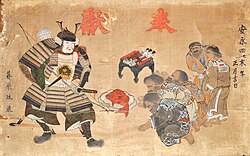Ainu people
The Ainu people are the native population of northern Japan and the eastern part of Russia, mostly in the Amur river region, Sakhalin, the Kuril islands and on the Kamchatka Peninsula. The term is also used for their culture[1] and language[2] in the Ezo region (Hokkaido).[3]
History
The majority of their ancestors, the Jōmon people, arrived in Japan about 30,000 – 15,000 years ago from Central Asia and southern Siberia.[4] They were largely replaced by the proto-Japanese which arrived from southeastern China about 2,000 years ago. The Ainu have strong similarities with Palaeolithic Europeans and people of the Middle East as well as with Native American groups of the northwestern coastal culture area in North America.[5] Some scholars think they were related to the Emishi of northern Honshu.
During and after the Yayoi period they were attacked by the early Japanese people. The Ainu and relative tribes lost most of their land in Honshū, many were killed or ensalved by the Yayoi-Japanese. After the rise of the Yamato, few Ainu were left in Honshu. After the Meiji restoration in the late 1800s, the Japanese began to colonize Hokkaido, sending their own people to live there. They forced the Ainu to leave the warm coast of Hokkaido and try to live in the mountains in the middle of the island. The Ainu were not allowed to fish for salmon or hunt deer. The Ainu were required to speak Japanese and use Japanese names. Japanese scientists and treasure hunters would dig up Ainu graves and steal the bodies and artifacts.[6]
The Ainu in Russia had more luck and lived their traditional life until the Second World War, when they were forced to act like other Russians.[7][8]
In April 2019, the Ainu became recognized as native population of northern Japan, and the rest of Japan has started to think of their culture as good and valuable.[6] However, the Ainu still face discrimination in Japan. Most Japanese outside of Hokkaido mistake the Ainu for foreigners or tourists.[9]
Culture
Their culture is based on the ancient Jomon culture of northern Japan and eastern Russia. Their native folk religion has some similarities to early Shinto. Their gods are named kamuy, similar to the Japanese Kami. They practiced agriculture but were also hunter gatherers. The Ainu are famous for their wood work and art.
The Ainu lived in villages called kotan and were often built along rivers or lakes. Every villages consisted of at least four to seven families, sometimes more than ten. The traditional house was called cise or cisey.
Language
They speak the Ainu language. The Ainu language is classificated as language isolate, although there exist several theories about a genetic relation. Some linguists suggest a relation to Altaic languages while others suggest a link to Indo-European languages.[10][11] Some similarities also exist with northern native American languages.[12]
Ainu People Media
French map from 1821 shows Sakhalin as part of Qing Empire, and the Kuril Islands are a part of Japan.
Ainu groups around the time of Shakushain's Revolt (1669–1672)
The samurai and the Ainu, c. 1775
A photograph of Tatsujiro Kuzuno, an Ainu individual famous for being a promoter of Ainu culture
A picture of Imekanu, right, with her niece Yukie Chiri, a famous Ainu Japanese transcriber and translator of Ainu epic tales. (1922)
References
- ↑ Batchelor, John. (1902). Sea-Girt Yezo: Glimpses at Missionary Work in North Japan, pp. 7-8.
- ↑ Nussbaum, Louis-Frédéric. (2005). "Ainu" in Japan Encyclopedia, p. 113.
- ↑ Nussbaum, "Ezo" at p. 184.
- ↑ Denoon, Donald; Hudson, Mark; McCormack, Gavan (November 20, 2001). Multicultural Japan: Palaeolithic to Postmodern. Cambridge University Press. ISBN 9780521003629.
- ↑ Old World sources of the first New World human inhabitants: A comparative craniofacial view - C. Loring Brace et al. 2001
- ↑ 6.0 6.1 Ellie Cobb (May 20, 2020). Japan's Forgotten Indigenous People. BBC. http://www.bbc.com/travel/story/20200519-japans-forgotten-indigenous-people. Retrieved June 25, 2020.
- ↑ Levinson, David (2002). Encyclopedia of Modern Asia. 1. Charles Scribner's Sons. p. 72. ISBN 978-0-684-80617-4.
- ↑ Walker, Brett (2001). The Conquest of Ainu Lands: Ecology and Culture in Japanese Expansion, 1590–1800. Berkeley: University of California Press. pp. 49–56, 61–71, 172–176. ISBN 978-0-52022-736-1.
- ↑ (in en-GB) Recognition at last for Japan's Ainu. June 6, 2008. http://news.bbc.co.uk/2/hi/asia-pacific/7437244.stm. Retrieved 2019-12-23.
- ↑ Zgusta, Richard (July 10, 2015). The Peoples of Northeast Asia through Time: Precolonial Ethnic and Cultural Processes along the Coast between Hokkaido and the Bering Strait. BRILL. ISBN 978-90-04-30043-9.
- ↑ Refsing, Kirsten. "Origins of the Ainu language : the Ainu Indo-European controversy". 新潟大学OPAC. Archived from the original on April 7, 2022. Retrieved December 21, 2019.
- ↑ https://www.sav.sk/journals/uploads/101415063_Tambovtsev.pdf
Other websites
| Wikimedia Commons has media related to Lua error in Module:Commons_link at line 62: attempt to index field 'wikibase' (a nil value).. |
- The Ainu Museum Archived 2005-08-28 at the Wayback Machine
- Smithsonian Institute[dead link]
- Nippon Utari Kyokai
- Institute for the Study of Languages and Cultures of Ainu
- Ainu-North American cultural similarities Archived 2003-09-27 at the Wayback Machine
- Spirit Cave Man May Rewrite Continent's History[dead link]
- Foundation for Research and Promotion of Ainu Culture Archived 2012-03-08 at the Wayback Machine
- Ainu Lineage
- The Boone Collection Archived 2009-03-18 at the Wayback Machine












